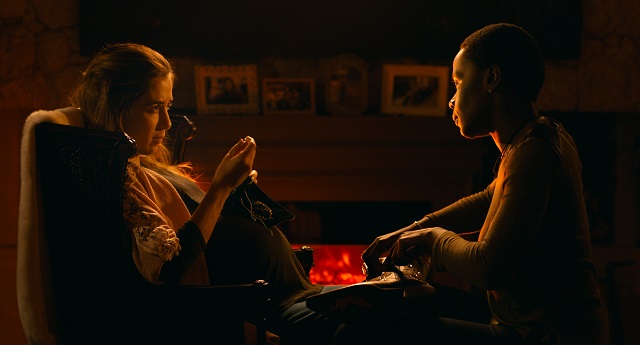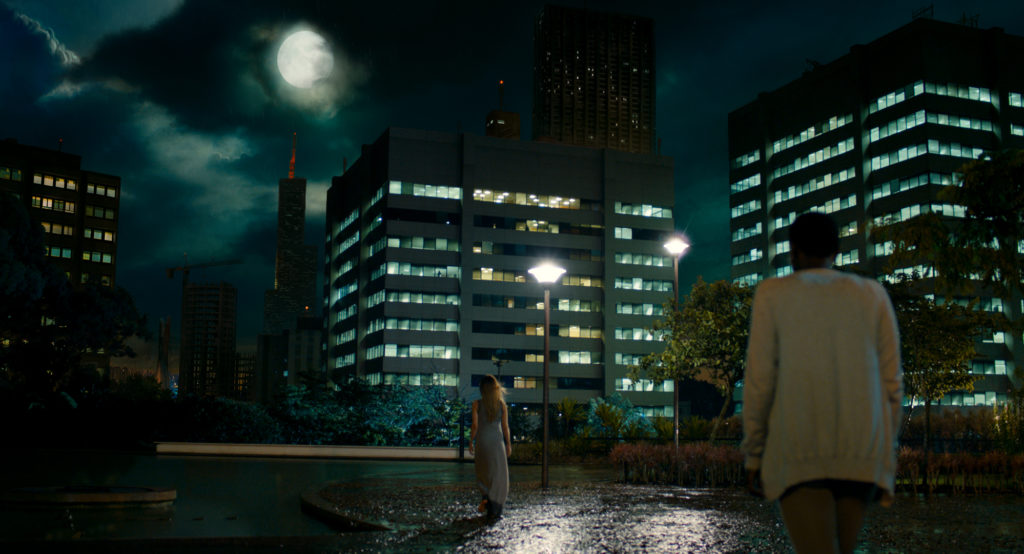
Brazilian directors Juliana Rojas and Marco Dutra have crafted one of the most surprising films of the year with ‘Good Manners’. After winning an award at Locarno for its unique combination of social realism with multiple genres, ‘Good Manners’ was also selected for the London Film Festival’s official competition. Rojas and Dutra came to present their film and we had the chance to talk with them about, among other things, their collaboration; their unique approach to genre; the social aspect of their work; their classic influences and a particularly distinctive use of colour. Check the interview in full here:
You were already at the LFF in 2011 with your first directorial collaboration,’Hard Labor.’ Your latest work expands the mix of realism and horror that was hinted on that early work.
Juliana: There are a lot of different elements in Good Manners that are apart but we wanted to put together, such as the social issues; the class difference in Brazil, the racial difference that is connected to class difference and also our relation with São Paulo; how do we like to portray the city. It also shows our interest in human relationships, using that mix of elements to talk about them. I think that’s something that good art and good films do, using those contrasts as metaphors for human conflict.
I would like to know a bit more about your approach to using multiple genres.
Juliana: This project in particular is the one we had the most fun with. We wanted to play with it. From the beginning we wanted it to be a fairy tale. We wanted to show a fantastic world and we wanted to include music. aA diverse mix of elements that was all guided by our characters. So we were very free and it was a very intuitive path.
Marco: In the case of Good Manners we knew we wanted to make a more fantastic film from the beginning. Because in Hard Labor there was an element of it bought into the story after the first half of the movie. In Good Manners we wanted to be there from the start, but we never discussed the form of the film beforehand. We began discussing this dream that I had about two women raising a monster baby. We wanted the birth of the baby to happen more or less in the middle of the film, so the structure would spread from the middle to all sides as we discuss the character.
Marco: We wanted to talk about a child’s delivery. The idea of a birth when the mother who raises the baby is not related to him by blood. A big influence was a Bertolt Bretch play called ‘The Caucasian Chalk Circle’ which tells the story of this woman who is left with the baby of the queen, a royal baby. She doesn’t really want him, but the play follows her for two years as she connects with the baby and raises him.
So were you trying to deliver some kind of Brechtian Metaphor?
Yeah, because we use some of his typical elements. It’s a crazy mix. We love Brecht and the way he describes his characters; his irony and also the way he uses music to narrate stories.

RG: This is your second collaboration as a directing team? How do you distribute the directorial tasks between the two of you?
We do everything together. It’s our second feature film together, but we have collaborated before. We have known each other for almost twenty years. We met at film school. So we’ve got a long story of collaboration that evolved through the years, but we have always worked on every detail very closely together, from discussing the story, to every single element, the shots…
RG: There are two particular elements from the screenplay that stand out. One is the social realism of the story that develop into tropes of horror genre, showing the class division in Brazil. Is that something that you particularly wanted to focus on? How did you balance this mix of elements?
Marco: First, the idea of the contrast for us is very important. When we decided it would be based on werewolf myths, it became very clear that contrast was very central to the story; one of the characters being rich, the other poor; one white, one black; the city centre and the periphery and the child and the wolf… Everything related to the idea of contrast and we allowed the film to explore that. It did visually through the matte paintings we made to show the city. São Paulo is a city divided by class struggle. There’s a lot of class struggle in Brazil. We wanted to make a shot that visually represented the ideas of centre and periphery. So we explore these contrasting ideas inside the fable, as we built the film. Like the inclusion of a boss and her employee, which is something that can be seen in our neighbourhood. That idea is part of our lives, that relationship between work and class that maybe we don’t think about it on an everyday basis, but it’s very important in one’s life.
RG: The second impressive element of the script is the introduction of an LGBT aspect. Were you interested on representing that particular audience?
Juliana: About the gay element. I think all those elements in the end come from our decision to make all of our characters somehow outcasts from society. Being gay is still not totally accepted and it relates to that. But also, because in the film, one of the issues of the werewolf is the conflict between his human rationality and the desire of his body. And we put that into all the characters in the way they deal with conflict. It represents a general human conflict: how we deal with our instincts, but at the same time how we manage to be in a society and have relationships. I think is a lot about our sexual passion and desire. And between the two women there’s the kind of relationship that breaks social and moral rules.
Marco: The title comes a bit from that. The idea of good manners. The idea of what is correct and incorrect behaviour, which could be either in a sexual relationship or in the werewolf child relationship (as in “you shouldn’t eat your friend” ) which manifest his struggle between instinct and rationality.

Did you unusual approach to screenplay writing caused any trouble with the producers?
Juliana: No. Our producer is very experienced. She produces a lot of independent films and she was very connected to the script process. That actually didn’t cause any problem. The main difficulty for the production came from the fact that it is actually a very complicated film which needed Special FX and, because of the visual concept, required very specific locations, art direction and cinematography, all of which made an impact in the required budget.
Marco: It was a hard film to produce, in that sense. It’s a French co-production and we benefited a lot from this partnership with France, particularly in the Special FX area. But there was one thing that our Brazilian Producer suggested. In an earlier version of the screenplay Joel (the werewolf child) died at the end. And that was the one thing she wasn’t keen on. Like “please, don’t kill Joel.” Actually, we knew she was right and finally we reached an ending that we all really liked.
RG: Another outstanding element in Good Manners is your treatment of colour? You even got some of the film painted. Were there any particular thoughts about it?
Juliana: We worked very closely with the production designer, Fernando Zuccolotto, and with Rui Poças, the cinematographer, and we did a lot of research. We worked with a lot of references, particularly from artists like Mary Blair who designed the art concepts of Disney classics such as Sleeping Beauty. For us it was very important to determine how each part of the film would look. The first part, which is Ana’s world is like the castle; the second part, Clara’s world, is like the Forest; like when ‘Snow White’ goes to the forest. Both parts have very distinctive colour palettes, a respective colour scheme that we agreed. And also in how would we brought the shadows and the textures of those parts. For the creation of a fantastic world, you have to have a lot of coherence. You can’t break the laws that you’ve created. Everything that you have in the scene is controlled, respecting the line of colours and the style.

RG: Talking about style, you’ve mentioned Disney, but were there other Hollywood classics that have influenced the aesthetics of the film?
Juliana: We were very inspired, particularly regarding the matte painting, which is the painting that you use to create a fake background, by the style that was very common in films from the 40’s to the 60’s. Today the use of matte painting is done in a CGI (computer generated images) way, but that style of films like Hitchcock’s or Mary Poppins it was painted. We wanted to create the same artificial feel, which is a realistic painting, but with something artificial. Also for that use of colour, we were advised by a matte painting artist.
Is that a deliberate Brechtian device?
Juliana: Yes. For distantiation.
The lighting is particularly influenced by Jacques Tourneur, by films like ‘Cat People’ and ‘I Walked with a Zombie’, because of the way he uses shadows and also how he works with suggestion. His films were very low budget, so he had no money for effects and he was very creative. He uses light and shadows to overcome budget restrictions.
RG: I wanted to talk a bit about your respective solo projects. Marcos, you were the screenwriter of ‘Futuro Beach’ and Juliana, before ‘Good Manners’, you directed ‘Necropolis Symphony’, which was never released in the UK. Could you tell us a bit about those projects?
Marco: I was one of the screenwriters of ‘Futuro Beach’…at this point, someone comes to remind us we only have a minute of interview left…
Juliana: ‘Necropolis Symphony’ is a musical comedy, is takes place in a cemetery and has also fantastic elements. It tells the story of a gravedigger who is afraid of his work. This cemetery has some trouble because is running out of space. They undergo a reform that is done by a woman from the city. The gravedigger falls for her but at the same time, as they have to move the graves, he becomes worry they may be disturbing the dead. It’s a romantic comedy, but also with a social commentary because what happens in the cemetery is what’s happening now in the cities. People from poor backgrounds are forced to move out of the centres, so they can build apartments for the rich.
‘Good Manners’ was one of the biggest surprises from this year’s London Film Festival. To this date, an UK release has not yet been confirmed. If you have the chance to catch it at any other film festival, don’t miss it!
